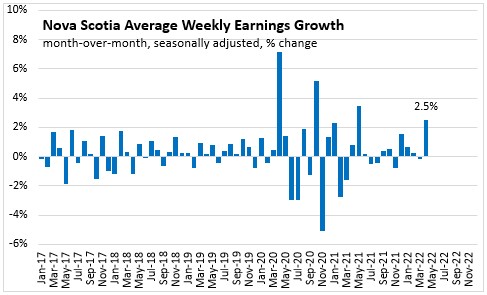The Economics and Statistics Division maintains archives of previous publications for accountability purposes, but makes no updates to keep these documents current with the latest data revisions from Statistics Canada. As a result, information in older documents may not be accurate. Please exercise caution when referring to older documents. For the latest information and historical data, please contact the individual listed to the right.
<--- Return to Archive
For additional information relating to this article, please contact:
June 24, 2022EMPLOYMENT, EARNINGS AND HOURS, APRIL 2022 PAYROLL EMPLOYMENT
Nova Scotia had 438,003 payroll employees in April 2022, up 0.8% (+3,557) compared to March 2022, and up 4.2% (+17,691) compared to April 2021. Nova Scotia's payroll employment had been trending upwards since 2017 but declined sharply between February and May 2020 due to restrictions and closures resulting from COVID-19. There was a partial rebound from June 2020 to April 2021 due to eased restrictions. Nova Scotia imposed restrictions again at the end of April 2021. These restrictions were eased part-way through June to December 2021. Nova Scotia's payroll employment returned again to a path of recovery starting in June 2021.
Canada had 17.5 million employees, an increase of 0.7% (+125,995) compared to last month and up 7.0% (+1,140,010) compared to a year ago. All provinces reported employment increases compared to last month. The largest payroll employment increases was observed in Alberta (+1.9%). The slowest payroll employment growth was observed in Quebec (+0.1%).


YEAR-TO-DATE (Jan-Apr 2022 vs. Jan-Apr 2021)
In January-April 2022, Nova Scotia's payroll employment increased 3.8% over January-April 2021. Nationally, payroll employment rose 7.5% in January-April 2022, with all provinces reporting increases. The largest payroll employment increases were observed in Ontario (+8.1%) and British Columbia (+7.9%). The slowest payroll employment growth was observed in New Brunswick (+3.6%) and Newfoundland and Labrador (+3.7%).

In January-April 2022, payroll employment was up 2.5% in Nova Scotia's goods producing sectors compared to January-April 2021. Goods sector payroll employment was up in all sub-sectors except forestry/logging, with construction (+3.6%) recording the largest gain.
Service sector employment was up 3.7% in January-April 2022 compared to January-April 2021. Service sector payroll employment increased the most in percentage terms in accommodation and food services, information and cultural, and arts, entertainment and recreation. Payroll employment decreased in management of companies and education.

AVERAGE WEEKLY EARNINGS

Nova Scotians' average weekly earnings (including overtime, seasonally adjusted) increased 2.5% (+$25.42) from March 2022 to $1,030.15 in April 2022. Average weekly wages were up 7.8% compared to April 2021. Canadians' average weekly wages increased 0.2% month to month ($1,170.10 in April 2022) and were 4.0% above wages a year ago.


Across the country, there were monthly increases in seven provinces, with the largest increases in Nova Scotia (+2.5%) and British Columbia (+1.3%). The largest decline was observed in Prince Edward Island (-0.6%).
Compared to a year ago, average wages were higher in all provinces, with Nova Scotia (+7.8%) recording the largest gain. The smallest gain was observed in Manitoba (+2.1%).

YEAR-TO-DATE (Jan-Apr 2022 vs. Jan-Apr 2021)
Compared to January-April 2021, Nova Scotia's average wages were up 4.9% in January-April 2022. Nationally, average wages were up 3.1% in the first four months of the year. Average wages were higher in all provinces, with the largest increases in percentage terms reported in Nova Scotia and New Brunswick (both +4.9%). The smallest gain was observed in Ontario (+2.1%).

In January-April 2022, average weekly earnings were up 2.8% in Nova Scotia's goods producing sectors over January-April 2021. Goods sector wages were up for construction and manufacturing sectors. Service sector average earnings were up 5.2% in January-April 2022. Service sector earnings increased the most in percentage terms in information and cultural (+18.3%) and health and social assistance (+11.6%). Service sector earnings decreased the most in transportation and warehousing (-2.9%).

REFERENCE TABLES - (January-April 2022 vs. January-April 2021)




Source: Statistics Canada. Table 14-10-0222-01 Employment, average hourly and weekly earnings (including overtime), and average weekly hours for the industrial aggregate excluding unclassified businesses, monthly, seasonally adjusted; Table 14-10-0223-01 Employment and average weekly earnings (including overtime) for all employees by province and territory, monthly, seasonally adjusted
<--- Return to Archive